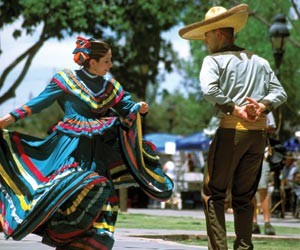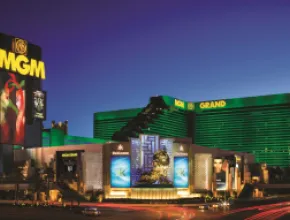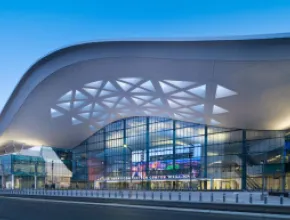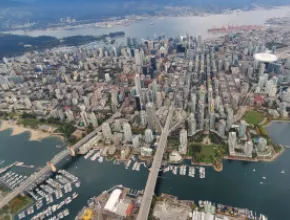New Mexico’s nickname is "Land of Enchantment," which evokes the mysterious power of the state’s landscape, history and people to transport visitors, at least temporarily, to another world. Each corner of the state has something magical to offer groups, whether from the Native American culture of the state’s Pueblo and Apache tribes, the traditions of the 400-year-old Spanish heritage or the sheer beauty of the state’s wildly varied canyons, plains and alpine forests.
Albuquerque
Albuquerque is New Mexico’s commercial and educational capital thanks to the presence of big institutions such as the University of New Mexico and chip-maker Intel. That’s a big change from the first Spanish settlers’ arrival by foot or on horseback in the early 1700s, and although Albuquerque is the sixth-fastest-growing city in America, it has worked hard to retain its Spanish Colonial heritage and Southwestern warmth, says Larry Atchison, vice president of convention sales, services and sports at the Albuquerque CVB.
"I think the heart and soul of our destination is our people, the welcoming environment they provide," Atchison says. "And it’s the perfect fit; it’s got a little bit of everything."
Like many Southwest cities, Albuquerque was originally built around a central plaza, and the residences, churches and government buildings surrounding it are today known as Old Town. The western part of Old Town has a tight cluster of attractions, including the Explora Science Center and Children’s Museum, the New Mexico Museum of Natural History and Science, and dozens of shops, boutiques and restaurants. In addition, the Albuquerque Museum, the city’s major fine arts venue, has lobby and special event space available for rent, just a short walk from the Albuquerque Plaza.
Near Old Town are the National Hispanic Cultural Center (NHCC) and the Indian Pueblo Cultural Center, a clearinghouse for information about New Mexico Native Americans that also houses museum exhibits and the Institute for Pueblo Indian Studies, which help give Albuquerque a distinct feel, according to Atchison.
"It’s unique, it’s its own place, it’s not something that’s created," he says. "Our Old Town has been in existence since it was created, and the church there—that church’s last relocation was in 1792."
The NHCC’s gorgeous performance and assembly spaces are available to groups, as are tours, with catering provided by La Fonda del Bosque restaurant. Similarly, the Indian Pueblo Cultural Center can provide flute players, Native American dance groups, storytelling and food demonstrations for groups of up to 550.
Albuquerque has also become known for the annual Albuquerque International Balloon Fiesta, one of the state’s most popular events as well as its most colorful, with hundreds of balloons taking to the skies at once each October. Groups can sponsor a balloon through a package that includes a logo on the balloon’s side and two rides, or volunteer to be part of a chase crew that pursues and helps land and take down a hot-air balloon once it’s safely on the ground.
Santa Fe and Taos
Santa Fe is New Mexico’s state capital and the terminus of the famed Santa Fe Trail.
Steve Lewis, spokesperson for the Santa Fe CVB, sees Santa Fe’s history as a crossroads for Hispanic, Native American and later European settlers, its tolerance and its artistic traditions combining to create a welcoming destination.
"People come here for the amazing amount of art—we’re the third-largest art market in the country, with over 240 galleries, over a dozen museums and thousands of resident artists," Lewis says.
This tradition dates back to Native American "functional" art, picking up momentum with the arrival of East Coast artists such as Georgia O’Keeffe in the early 20th century.
"They were looking for new stimulation and found this Native American culture and this terrific light and remarkable landscape," Lewis says.
Santa Fe celebrates its 400th anniversary in 2010, and high points include a Labor Day weekend fiesta called Viva Santa Fe and a New Year’s Eve gala at the Santa Fe Convention Center.
The city’s downtown centers on the plaza, which offers visitors compact doses of Southwestern arts and history at the New Mexico Museum of Art, Site Santa Fe art space and New Mexico History Museum. Group tours are available at the New Mexico Museum of Art and the New Mexico History Museum. The New Mexico Museum of Art’s rentable spaces include the St. Francis Auditorium, O’Shaughnessy and West sculpture gardens, and the central courtyard.
Santa Fe is also arguably New Mexico’s performing arts center, especially during the summer when the Santa Fe Opera blooms, the Santa Fe Chamber Music Festival takes place and the Maria Benitez Teatro Flamenco performs for 12 weeks.
An elevation of 7,000 feet gives Santa Fe an alpine feel, and a generally mild climate makes it an ideal place for outdoor adventures in surrounding areas such as the 1.5 million-acre Santa Fe National Forest.
Then there’s the food.
"We have our own regional cuisine, which is very distinctive. A lot of people think it’s generic Mexican, but that’s not the case; it’s unique," Lewis says.
That uniqueness stems from local red chile or green chile specialties and from great chefs who have established themselves here. Locals recommend restaurants such as La Choza, the Shed, Los Mayas or Los Potrillos for both good food and ambience.
About 70 miles northeast of Santa Fe is Taos, famed as an artists’ colony and for Taos Pueblo, an ancient Pueblo adobe community along the Rio Pueblo River.
"It’s been continuously inhabited for 1,000 years. It’s a World Heritage Site—the only one where people are actually living there," says Steve Fuhlendorf, CEO of the Taos County COC and Visitor Bureau, who notes that Taos Pueblo’s full-time residents live as they have for centuries, with no running water or electricity, and kiva fireplaces heating their homes.
"And each February and March, they close the pueblo and only speak the Tiwa language," Fuhlendorf says. "It’s a way of connecting the children and reconnecting the adults with their traditional culture and ceremonies, and no one outside the tribe is allowed to be in there during that time."
The rest of the year, however, groups are welcome and can tour the pueblo with guides. Additional Native American sites in this area include Pot Creek to the east, a 700-year-old site that is currently undergoing archeological excavation, and the Ojo Caliente hot springs.
Traditions here also stem from 400 years of Hispanic culture, Fuhlendorf says, including a big summer fiesta and the Christmas celebrations of Los Pastores and Las Posadas. Several circa-1700 adobe churches are still active in Taos, and parishioners "re-mud" them each spring, while in nearby Ranchos de Taos is St. Francis church, fondly known as "Our Lady of Ansel Adams," since Adams, among many others, helped make it the Southwest’s most photographed and painted church.
The central plaza in Taos is the site of various shops and cultural activities, including a summertime Thursday night chamber music program that attracts nearly a thousand listeners each week.
Northwestern New Mexico
The northwestern part of the Land of Enchantment features both living and archeological Native American culture, and is the place where any misperceptions of New Mexico as hot, flat desert are proven wrong, according to Tonya Stinson, marketing manager for the Farmington CVB.
"Two-thirds of the surface water in New Mexico flows through Farmington, and we’re at the junction of three rivers. We’re at 5,300 feet and have three distinct seasons," Stinson says.
Farmington today is centered on several scenic and cultural attractions. It is just 30 minutes by car from a Navajo reservation, with Mesa Verde National Park, Chaco Culture National Historic Park and Aztec Ruins National Monument also nearby.
"There’s a huge cultural influence from that, [which makes] Farmington great for day trips; you can stay several days and go in all different directions," Stinson says, noting that local guide Larry Baker and his staff can interpret during tours through Chaco Canyon or while viewing Lago Canyon’s rock art, or he can also speak after a group’s dinner.
Groups can also easily take self-guided tours of the Salmon Ruins or Aztec Ruins, both of which also have museums.
The Farmington area has several high-quality trading posts as well, and owners of posts such as Hogback Trading can discuss Navajo culture at length with a backdrop of handmade jewelry, pottery and rugs.
The plateau that Los Alamos occupies has been inhabited for thousands of years, according to Kevin Holsapple, executive director of the Los Alamos COC.
"Bandelier National Monument is one of the premier places to understand the Pueblan cultures that predated Western influences and the Spanish," he says. "So what you’ll find is a landscape laced with remnants of Native American culture."
And that’s just outside of town; Los Alamos proper offers its own trip through history.
"Right within our downtown you can walk through 1,000 years of history in a three-block area," Holsapple says, adding that in the 1940s, Los Alamos was chosen as the headquarters for the Manhattan Project and requisitioned the Los Alamos Ranch School. "So you can literally go from those Native American ruins circa 1200 or 1000 A.D. to modern times."
Groups that travel to nearby Bandelier National Monument can be escorted by a Native American ranger who discusses pueblo traditions while tribes above play drums and carry torches through the cliff dwellings.
In addition, the Los Alamos Historical Archive has an excellent archive of documents and artifacts that may enhance visitors’ understanding of Los Alamos-area culture, and the 100,000-acre Valles Caldera National Preserve offers group activities ranging from evenings of astronomy to afternoons of fly-fishing.
Southern New Mexico
Chris Faivre, media and public relations manager for the Las Cruces CVB, says southern New Mexico is heavily influenced by Mexican culture, where the north is strongly influenced by Native American culture.
"The Mesilla Plaza is the epicenter for that [cultural heritage]," Faivre says, pointing to the mariachis on Sundays and the main Mexican cultural festival of Diez y Seis de Septiembre every year.
The plaza, originally built for defense against raiding Apaches, has also seen the raising of the U.S. flag following the Gadsden Purchase, and a deadly riot between Democrats and Republicans following an 1871 political dispute. Now a National Historic Landmark, the plaza is ringed by shops, galleries and restaurants that make it ideal for a stroll.
The New Mexico Farm & Ranch Heritage Museum in Las Cruces also draws heavily from Mexico, which contributed agricultural methods still in use throughout the state. It has several indoor spaces for events, plus an outdoor courtyard that sports beautiful views of the nearby Organ Mountains.
While Las Cruces has one foot planted in history, the other is planted in the future thanks to Robert Goddard’s rocketry experiments in nearby Roswell, Clyde Tombaugh’s tenure at New Mexico State University after he discovered Pluto, and the presence of Spaceport America, the world’s first commercial spaceport, according to Faivre.
"And because of what goes on at White Sands Missile Range, there’s always been a cutting-edge space history that runs through the area," he says. "Then right across the valley you get right into this traditional, agriculture-based way of life."
Spaceport America Hardhat Tours, covering the area’s history from its Native American beginnings to the construction of the Spaceport’s launch facilities, are given daily from a starting point in Truth or Consequences.
Roswell’s name is indelibly connected to the alleged crash landing (in 1947) of a UFO a few dozen miles away. The Air Force insists the recovered debris was from an experimental type of weather balloon, but nevertheless, the city’s name has become pop culture shorthand for visits by aliens.
Roswell embraces this heritage through the International UFO Museum and the Roswell UFO Festival that takes place each July. More terrestrial pursuits here include visits to the Bitter Lake National Wildlife Refuge and Carlsbad Caverns about 75 miles away. Groups may tour the caverns in the company of a knowledgeable ranger.
Ruidoso’s background is more Wild West, particularly since the major events of a certain outlaw’s life played out here.
"This is Billy the Kid country," says Sandi Aguilar, executive director of the Ruidoso Valley COC. "The town of Lincoln, where Billy the Kid was held, just a couple miles from here, is a very small, very quaint town, and you can still walk through the jailhouse and courthouse, which are museums now."
Visitors can also stay overnight in some of the town’s historic buildings, Aguilar says, and visit the Ruidoso River Museum, which has colorful artifacts, including the solid-gold sheriff’s badge of Pat Garrett, who shot Billy the Kid.
Ruidoso stands at an elevation of around 7,000 feet, and the one-hour drive that makes up the Billy the Kid Scenic Byway passes through some spectacular alpine and river scenery, as well as the lava-covered plains around Carrizozo.
To Ruidoso’s west is Alamogordo and White Sands National Monument, the portal to 275 square miles of spectacular white gypsum dunes. White Sands offers a series of small-group workshops and talks on subjects ranging from successfully photographing the brilliant-white dunes to the history and character of the area known as the Tularosa Basin.
Paul D. Kretkowski prefers red and green chiles.






